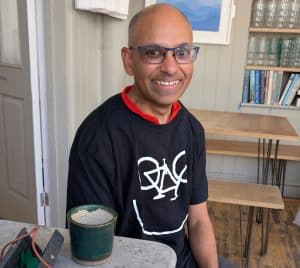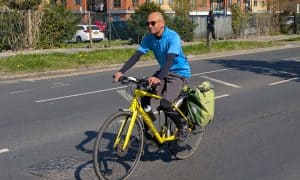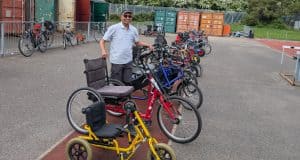We love cycles and we love people’s cycle stories. Our Staff and Trustees share our passion, and we wanted to share it with you too! Our Cycle Stories is a new blog series devoted to introducing you to our wonderful team, and the diverse and varied ways that cycling has become an enriching part of their lives.

What is your name, and what do you do at Wheels for Wellbeing?
My name is Charlie Fernandes. I have and have had a few working hats at Wheels for Wellbeing. I’m a Cycling Instructor, I coordinate our Led Rides programme, administer our photobank, do community engagement and most recently coordinate our Bikeability cycle training programme.
What has been your career trajectory; how did you come to end up working at WfW?
Before joining WfW, I had worked in software programming, fundraising, mental health and community engagement, project support for charities, and cycle training work. Phew!
I was an active volunteer campaigner with my local Brent Cycling Campaign and developed an appreciation that disabled cyclists could be a natural ally to, and integrated into, better cycle campaigning. The inclusive cycling organisation that consistently stood out to me was WfW. I had a gap between projects, and at that exact time an opening appeared with WfW to coordinate the Led Rides programme, which I embraced and have come to love.
Do you use a cycle? What/how/where?
I ride a Specialized Sirrus hybrid cycle. The riding position is sufficiently upright to take in the surroundings and lead rides, but also streamlined enough to ride faster on longer commutes. The medium tyres give the flexibility to ride on gravel paths as well as tarmacked roads. Its bright yellow colour is distinctive and easily noticeable!
I live in Wembley and ride through the city or West London to work in South London, so often find myself commuting using the route of the led rides I’d be planning. I love the C6 cycleway, as not only is it a great north-south route through the city, it also has sentimental value to me as it passes two of my workplaces from many years ago. As well as the nostalgic value in seeing how the areas have changed, I also love how the route uses a number of types of active travel infrastructure. I like to explore different routes, types of infrastructure, good and bad, across the different boroughs of London.

What does cycling mean to you, and your overall wellbeing?
I can describe my life in two parts. Before my cycling life, I was dependent on public transport. I also had bouts of depression. Since first buying a cycle, so much has opened up to me. It might be a cliché to say it’s my life, but cycling really means the world to me. Not only is cycling integral to my work, cycling is also my transport, my physical and mental wellbeing, my passion.
Yet it’s through my contact with hundreds of disabled people who come to ride at our inclusive traffic-free sessions that helped me realise yet another aspect of why they – and I – love cycling. There’s an enjoyment inherent in cycling. The simple pedalling action that efficiently propels you to smoothly glide along is so elegant, it’s like poetry. And with a variety of types of cycle and accessories available, cycling becomes so inclusive of all. We can expand the horizons- not only of the riders, but of society more broadly.
Cycling, and particularly inclusive cycling, has been a gateway drug for me, expanding my interests into design of the public realm.
Do you have a favourite session, route, or adventure?
When Westminster Council installed what is believed to be the UK’s first hangar to accommodate non-standard cycles for residential use, local residents planned a celebratory launch event. WfW was invited to run an inclusive ride to visit it.
I knew it would be an event of significant importance to WfW. As well as the ride, we’d also be demonstrating why such hangars for non-standard cycles are necessary, so it would have a strong campaign element too. Starting from our base in Herne Hill, south London, we’d ride to the event in St John’s Wood, north west London, enjoy the event, and return back. The round trip would be over 20 miles.
Our ride went so incredibly smoothly, we arrived at the event ahead of schedule, with time to relax. Other led rides arrived. Our Director gave a speech. Disabled cyclists tested how their trikes could fit into the hangar. We were interviewed by journalists.
Later that evening I chose to ride home via the same route, passing St John’s Wood. I was reminiscing about how we enjoyed the nice sections and managed the difficult parts. I was marvelling with pride at our team and riders and what we had achieved. I was filled with emotion. That was a special ride. I think of it often.

Is there anything that you think WfW does better than anyone else?
Every week WfW is directly serving hundreds of disabled people. And we’re truly a Disabled People’s Organisation (DPO), with disabled people among trustees, director, staff in frontline operations and campaigns work and volunteers. I believe all this gives WfW a unique and well-founded basis to campaign for progress in #InclusiveCycling and #ActiveTravel. It allows WfW to publish substantive items such as the Guide to Inclusive Cycling, from a position of real knowledge and expertise. I feel honoured to work for who I think are the leading organisation to bring about a world of inclusive active travel.
If you had a magic wand, what one thing would you change in #ActiveTravel #InclusiveCycling to benefit Disabled people, their mobility, and their wellbeing?
If I had a magic wand, I would sprinkle the magic dust to create more inclusive modal filters. By explanation, modal filters restrict through motor traffic, while allowing walking, cycling and wheeling. And by inclusive, they should allow the wide variety of non-standard cycles with ease, convenience and comfort. This should encompass making existing modal filters to be made fully inclusive, too. It should also encompass the removal of barriers in parks and shared use paths and other traffic-free routes and spaces, which currently discriminate against disabled cyclists.
More inclusive modal filters would go a considerable way towards developing conditions for more inclusive active travel. More disabled people could be enticed towards exploring and embracing inclusive cycling. This could lead to a sense of independence, empowerment ,and greater wellbeing for many more disabled people. The resulting greater awareness of disabled cyclists could also naturally encourage inclusive led rides to become more mainstream, enabling disabled people to partake in more social activities.
Thank you for sharing your Cycle Story with us, Charlie!
